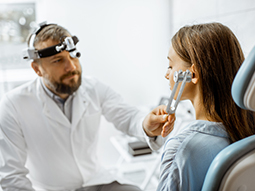Hearing test: audiometry and tympanometry
Audiometry
Audiometry is a hearing test. It is used to measure hearing loss.
How the test is performed?
This is generally how the test is conducted:
Earphones will be placed on your head. These earphones are attached to the audiometer, a machine that delivers sounds to your ears. Pure tones and speech are delivered to one ear at a time. You are asked to raise a hand, press a button, or otherwise indicate when you hear a sound. The minimum intensity (volume) required to hear each tone is graphed. An attachment called a bone oscillator is placed against the bone behind each ear (mastoid bone) to test bone conduction. An audiologist will interpret the test.
This test does not hurt and can take up to one hour. You will feel no aftereffects.
Tympanometry
Tympanometry is a test used to detect disorders of the middle air. Tympanometry may reveal any of the following:
-
Fluid in the middle ear
-
Perforated ear drum
-
Impacted ear wax
-
Scarring of the tympanic membrane
-
Lack of contact between the conduction bones of the middle ear
-
A tumor in the middle ear
How the test is performed?
A soft tip plug is placed in your ear that will change the pressure in your ear, produce a tone, and measure your responses to the sound and different pressures. During the test, it is important to stay as still as possible and not speak. There may be some discomfort while the probe is in the ear, but there is no risk. You will hear a loud tone as the measurements are taken.
This test is part of a hearing test and takes fewer than 5 minutes. You will feel no aftereffects.
Videonystagmography or balance test (ENG)
Electronystagmography is a test used to evaluate the balance portion of the inner ear and some parts of the brain involved in the balance system. which provides hearing and helps with balance. The test is used to help determine what may be the cause of dizziness or vertigo.
How the test is performed?
During an ENG test, eye movements are recorded by special video cameras fitted on goggles placed over the eyes. An audiologist measures the eye movements and shows the kind of messages the inner ear is sending to control the movement of the eyes through the central nervous system.
During the first part of the test, the patient stares at a spot or a light. Next, they watch a light moving on a bar. The third part of the test records eye movements as the patient lies on a bed in different positions (lying on right side, left side, etc.). During the final portion of the test, warm and/or cool water or air will be placed in the outer ear canals.
The test does not hurt, but you may feel dizzy afterwards, so it is best to have someone who can drive you home. The test should not take longer than one hour.
Electrocochleography (ECOG)
ECOG is a test used to examine electrical potentials in the ear. It may be useful for diagnosing:
-
Ménière's disease
-
Perilymphatic fistula
How the test is performed?
In this test, a recording electrode is placed into the subject's ear canal, via a foam tip. An electrode is also placed on your forehead. You will hear a series of audible clicks.
This test does not hurt. This test takes at least one hour and you should feel no aftereffects.
Brainstem auditory evoked response audiometry (BAER, BSER)
The brainstem auditory evoked response test is performed to assess auditory nerve and auditory brain stem function.
How the test is performed?
You will lie on a reclining chair or bed and remain still. Electrodes will be placed on your forehead and on each earlobe, or behind your ears. You hear clicking noises or tones through earphones and the electrodes pick up the brain's response and record it on a graph.
This test does not hurt. The test takes at least 1 hour and you should feel no aftereffects.
VEMP (Vestibular evoked myogenic potentials)
VEMP testing is used to diagnose some uncommon disorders of balance.
-
Superior semicircular canal dehiscence
-
Perilymphatic fistula
-
Meniere’s disease
How the test is performed?
A surface electrode is placed on your neck and you will be asked to turn your head to one side. Sounds will be delivered to your ear and how your brain responds to these sounds will be measured.
This test does not hurt and you will feel no aftereffects.
Our providers

Expert ENT care
Getting the care you need starts with seeing one of our ENT specialists.









